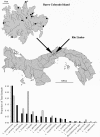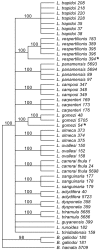Lutzomyia sand fly diversity and rates of infection by Wolbachia and an exotic Leishmania species on Barro Colorado Island, Panama
- PMID: 20231892
- PMCID: PMC2834748
- DOI: 10.1371/journal.pntd.0000627
Lutzomyia sand fly diversity and rates of infection by Wolbachia and an exotic Leishmania species on Barro Colorado Island, Panama
Abstract
Background: Sand flies (Diptera, Psychodidae, Phlebotominae) in the genus Lutzomyia are the predominant vectors of the protozoan disease leishmaniasis in the New World. Within the watershed of the Panama Canal, the cutaneous form of leishmaniasis is a continuous health threat for residents, tourists and members of an international research community. Here we report the results of screening a tropical forest assemblage of sand fly species for infection by both Leishmania and a microbe that can potentially serve in vector population control, the cytoplasmically transmitted rickettsia, Wolbachia pipientis. Knowing accurately which Lutzomyia species are present, what their evolutionary relationships are, and how they are infected by strains of both Leishmania and Wolbachia is of critical value for building strategies to mitigate the impact of this disease in humans.
Methodology and findings: We collected, sorted and then used DNA sequences to determine the diversity and probable phylogenetic relationships of the Phlebotominae occurring in the understory of Barro Colorado Island in the Republic of Panama. Sequence from CO1, the DNA barcoding gene, supported 18 morphology-based species determinations while revealing the presence of two possible "cryptic" species, one (Lu. sp. nr vespertilionis) within the Vespertilionis group, the other (Lu. gomezi) within the Lutzomyia-cruciata series. Using ITS-1 and "minicircle" primers we detected Leishmania DNA in 43.3% of Lu. trapidoi, 26.3% of Lu. gomezi individuals and in 0% of the other 18 sand fly species. Identical ITS-1 sequence was obtained from the Leishmania infecting Lu. trapidoi and Lu. gomezi, sequence which was 93% similar to Leishmania (viannia) naiffi in GenBank, a species previously unknown in Panama, but recognized as a type of cutaneous leishmaniasis vectored broadly across northern and central South America. Distinct strains of the intracellular bacterium Wolbachia were detected in three of 20 sand fly species, including Lu. trapidoi, in which it frequently co-occurred with Leishmania.
Conclusions: Both morphological and molecular methods were used to examine an assemblage of 20 sand fly species occurring in the forests of the Panama Canal area. Two of these species, members of separate clades, were found to carry Leishmania at high frequency and hence are likely vectors of leishmaniasis to humans or other mammal species. A single Leishmania species, identified with high confidence as Le. naiffi, was carried by both species. That Le. naiffi is known to cause cutaneous lesions in South America but has hitherto not been reported or implicated in Panama opens the possibility that its range has recently expanded to include the Isthmus or that it occurs as a recent introduction. The occurrence of Leishmania and Wolbachia in Lu. trapidoi identifies one important vector of the disease as a potential target for gene introductions using Wolbachia population sweeps.
Conflict of interest statement
The authors have declared that no competing interests exist.
Figures



References
-
- Chappuis FS, Sundar A, Hailu H, Ghalib S, Rijal R, et al. Visceral leishmaniasis: what are the needs for diagnosis, treatment and control? Nat Rev. 2007;5:S7–S16. - PubMed
-
- Reithinger R, Dujardin JC, Louzir H, Pirmez C, Alexander B, et al. Cutaneous leishmaniasis. Lancet Infect Dis. 2006;7:581–596. - PubMed
-
- Desjeux P. Focus: Leishmaniasis. Nat Rev Microbiol. 2004;2:692. - PubMed
-
- Reithinger R. Leishmaniases' burden of disease: ways forward for getting from specdulation to reality. PLoS Negl Trop Dis. 2008;2:e285. doi: 10.1371/journal.pntd.0000285. - DOI - PMC - PubMed
Publication types
MeSH terms
Substances
Associated data
- Actions
- Actions
- Actions
- Actions
- Actions
- Actions
- Actions
- Actions
- Actions
- Actions
- Actions
- Actions
- Actions
- Actions
- Actions
- Actions
- Actions
- Actions
- Actions
- Actions
- Actions
- Actions
- Actions
- Actions
- Actions
- Actions
- Actions
- Actions
- Actions
- Actions
- Actions
- Actions
- Actions
- Actions
- Actions
- Actions
- Actions
- Actions
- Actions
- Actions
- Actions
- Actions
- Actions
- Actions
- Actions
- Actions
- Actions
- Actions
- Actions
- Actions
- Actions
- Actions
- Actions
- Actions
- Actions
- Actions
- Actions
- Actions
- Actions
- Actions
- Actions
- Actions
- Actions
- Actions
- Actions
- Actions
- Actions
- Actions
- Actions
- Actions
- Actions
- Actions
- Actions
- Actions
- Actions
- Actions
- Actions
- Actions
- Actions
- Actions
- Actions
- Actions
- Actions
- Actions
- Actions
- Actions
- Actions
LinkOut - more resources
Full Text Sources
Molecular Biology Databases
Miscellaneous

